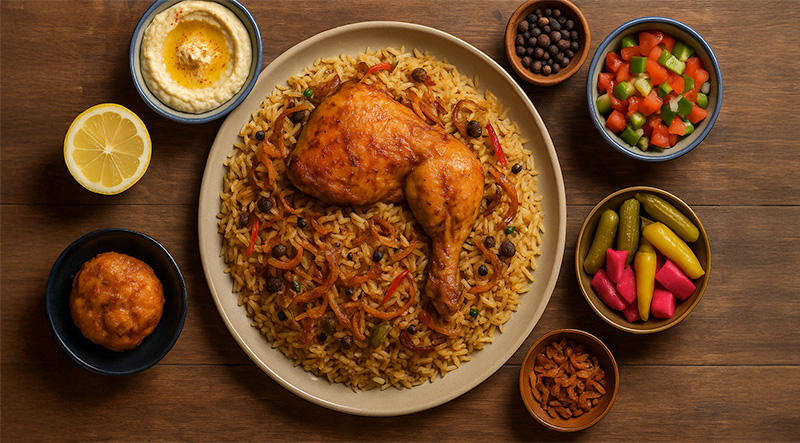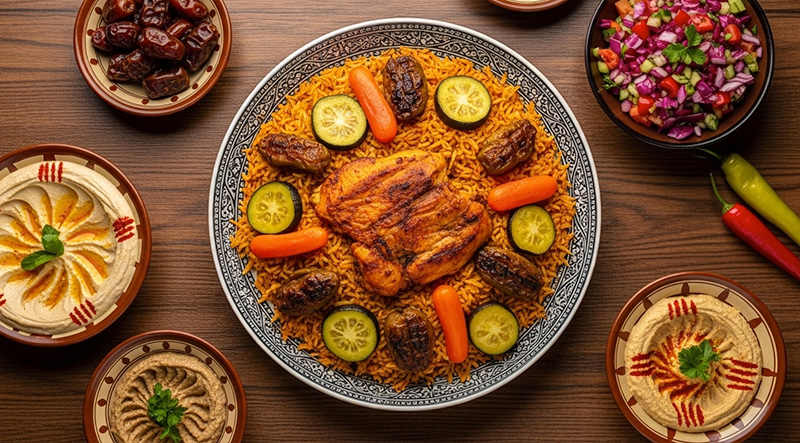A beloved national dish and the epitome of Kuwaiti hospitality, Machboos is fragrant, golden, and bursting with Gulf flavor. Dried black lime (loomi) adds a deep, citrusy tang to this fragrant rice dish, which is slow-cooked with tender lamb, chicken, or fish and spiced with cardamom, turmeric, and cinnamon. With fluffy basmati rice absorbing every savory note, each spoonful offers a rich harmony of textures and spices. Machboos is more than just a meal; it's a celebration of tradition on every plate, and it's frequently served with a side of dakkous, a fresh tomato-garlic sauce. Read More...
The History of Kuwait’s National Dish – Machboos:
In the warm, spice-scented kitchens of Kuwait, no dish holds more prestige, history, or cultural pride than Machboos. A fragrant medley of spiced basmati rice, meat, and dried black lime, Machboos (also spelled Majboos or Machbus) has become more than just a staple meal—it is a culinary emblem of Kuwaiti identity, served during celebrations, religious holidays, and family gatherings.
A Dish with Deep Roots:
Though deeply associated with Kuwait today, Machboos’ origins are woven through the broader Gulf and Indian Ocean region. The dish evolved from ancient rice-based meals brought by traders and sailors navigating between the Arabian Peninsula, Persia, India, and East Africa. As Indian basmati rice and warming spices like cloves, cinnamon, turmeric, and cardamom made their way to the Arabian Gulf through centuries of trade, Kuwaiti cooks adopted and adapted them into a uniquely local creation.
At its core, Machboos draws inspiration from the Indian biryani and Persian pilaf, but what sets it apart is the signature use of loomi, the dried black lime that gives Kuwaiti Machboos its characteristic tangy depth. This preservation method—sun-drying limes until they turn nearly black—was a practical innovation in arid climates, and it has become a defining element of the Gulf’s flavor profile.
The Anatomy of Machboos:
A traditional Machboos begins by simmering meat—usually lamb, chicken, or fish—in a heavily spiced broth. This not only cooks the protein to tender perfection but infuses the base with aromatic flavor. Once the meat is removed, basmati rice is added to the broth, absorbing the complex mix of seasonings, including bay leaves, saffron, and the essential dried lime.
The final dish is often layered: the meat nestled on top of golden rice, garnished with fried onions, raisins, or roasted nuts, and served with dakkous, a garlicky tomato sauce that cuts through the richness with a fresh, zesty punch.
A Centerpiece of Kuwaiti Culture:
Machboos is more than a meal—it’s a ritual in many Kuwaiti households. It’s the centerpiece at Friday family lunches, the dish of honor during Eid celebrations, and a must-have at weddings and national holidays. Its preparation is a point of pride, often passed from generation to generation with each family adding their own twist—be it a special spice mix, a meat preference, or the choice of garnish.
In traditional Bedouin communities, Machboos symbolized hospitality and wealth, as rice and spices were once rare and valuable commodities. Serving Machboos to a guest was—and still is—a gesture of great generosity and respect.
Machboos in the Modern World:
Today, Machboos remains a cherished dish not only in Kuwait but across the Arabian Gulf, including Bahrain, Qatar, Saudi Arabia, and the UAE, each with slight regional variations. Yet in Kuwait, it holds an unmatched status as the national dish, appearing in both humble home kitchens and elegant banquets.
Its enduring popularity also reflects Kuwait’s broader culinary identity—a blend of Arab, Persian, Indian, and East African influences, shaped by seafaring history, trade, and a deep-rooted love for bold, nourishing food.
Machboos – A Taste of Kuwaiti Heritage:
To taste Machboos is to experience the essence of Kuwait: warm, welcoming, and richly layered. Every bite tells a story of centuries-old trade routes, family traditions, and the enduring value placed on food as a source of comfort, pride, and connection. Whether enjoyed with loved ones during a feast or served to guests as a symbol of hospitality, Machboos remains Kuwait’s most flavorful link between the past and present.
Sear the Meat:

Add Spices & Simmer:
Prepare the Rice:

Finish the Dish:
Serve:

Tips & Variations:
The total preparation and cooking time for Machboos is approximately 1.5 to 2 hours. Initial preparation, including soaking the rice, chopping onions, garlic, and tomatoes, and gathering spices, takes about 20–30 minutes. Browning the meat and building the base flavor with aromatics and spices requires another 15–20 minutes. Depending on the meat type, simmering can take 30–90 minutes—shorter for chicken, longer for lamb. Finally, cooking the rice in the flavorful broth takes an additional 15–20 minutes, followed by a short resting period to steam and meld flavors. With careful timing, Machboos can be made efficiently and is well worth the effort for its rich, layered taste.
A single serving of Machboos, based on the traditional recipe provided, contains approximately 600–800 calories, depending on portion size and the type of meat used. The basmati rice accounts for around 200–250 calories per cup, while the meat—whether chicken or lamb—adds 250–400 calories, depending on fat content and serving size. The oil or ghee, used for sautéing, contributes about 100–150 calories, and the spices and vegetables add minimal calories but a lot of flavor. Optional toppings like toasted nuts or raisins can add another 50–100 calories. Despite its richness, Machboos is a well-balanced dish offering protein, carbs, and healthy fats in every flavorful serving.







